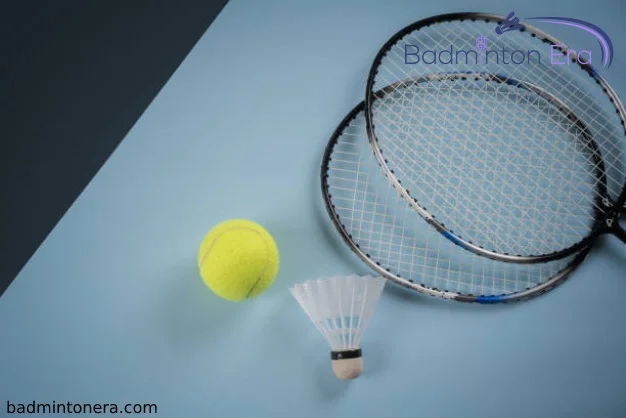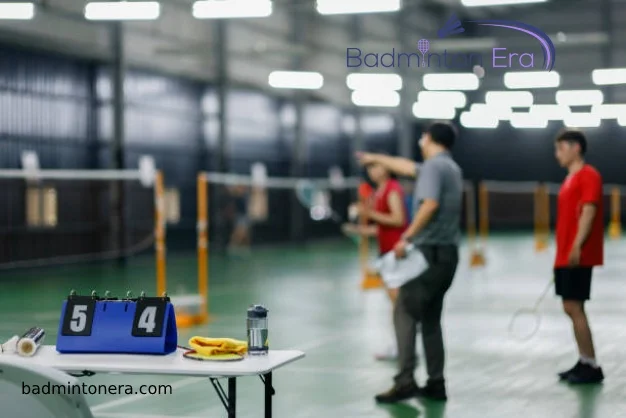Badminton vS. Tennis
Let’s discuss Badminton VS. Tennis. Tennis and badminton both have several similarities, yet the two sports are frequently compared. Both sports use a racquet and take place on a court that is separated into two halves by a net. Tennis and badminton are racquet sports that are both played on a rectangular court with a net in the center. Tennis was invented in England in the 1870s, whereas badminton dates back roughly a thousand years to India. Both of these sports may be played alone or in pairs because they have a lot in common, yet are different from one another.
However, there are several significant distinctions between the two sports, and understanding them might help you decide which could be a better choice for you.
So, let’s dive in to see these differentiations:

Scoring Method Badminton vS. Tennis:
Tennis and badminton both use sets as a matching mechanism. The sole distinction between badminton and tennis is that there are two or three sets in badminton, with each set going to the player who reaches number 21 first with a 2-point advantage. A player must win two of these three sets to win a match.
In contrast, tennis has a more complicated point system. In tennis, each point is worth 15, 30, or 40 points.
Shuttle/ Ball Speed:
People frequently assume that because tennis courts are larger and rackets are heavier, so the ball would move faster. Contrary to popular belief, badminton is a speedier sport than tennis. The fastest shot in badminton was recorded at 426 km/h, whereas the fastest shot in tennis was 263 km/h.
Equipment:
Tennis rackets, which are somewhat heavier than those used in badminton and weigh between 250 and 360 grams, are different from those used in badminton. The perfect badminton racquet, though, weighs less than 100 grams.
In badminton, a shuttlecock is used, whereas, in tennis, a hard-felt ball is used. Tennis shoes, which tend to be attractive with specially created designs on the sole, are different from badminton shoes in terms of requirements. On the other hand, badminton courts inside require non-marking shoes.
Court Dimensions and Layout:
Tennis and badminton are both played on rectangular courts, but their configurations and sizes differ from one another.
In comparison to a badminton court, which is 44 feet long and 20 feet wide, a tennis court is 78 feet long and 36 feet wide. The size of a typical badminton court is double that of a tennis court.
A tennis net is positioned around 36 inches above the ground, but a badminton net is positioned 60 inches above the ground. The nets used in these sports are similarly varied in size and design.
Outside/ Indoor sports:
Badminton is a leisure activity that may be played both inside and outside, although most people choose to play it in their gardens, on beaches, and in their backyards. But the BWF has included this sport in its official list of indoor sports. On the other hand, tennis is played outside on a surface made of clay, synthetic materials, or grass. Tennis may be played indoors as well, although all big competitions are held outside.
International Participation:
The fact that badminton is the second most popular sport in the world (after football) and that 339 million people play it every day throughout the globe may surprise you.
Tennis, on the other hand, is the sixth most popular sport in the world, according to participation. It is believed that more than 60 million individuals play this sport every day around the world, according to surveys and studies.
Service:
Tennis and badminton have diverse serving styles and are one of the key components of racquet sports. Tennis serves can be delivered overhand or underhand. However, badminton serves must be delivered below the waist and underhand. In addition, if you make a mistake with your first serve in tennis, you have another chance, which is not the case in badminton.
Standard Shots:
Apart from serving, there are six more keystrokes in badminton: clear, drop, drive, lift, smash, and dribbling.
The four primary shots in tennis. For instance, the drop, forehand/backhand groundstroke, lob, and volley.
Footwork:
Tennis players tend to use sharper movements, running, and abrupt starts and stops than badminton players do. The footwork patterns between the two sports are just marginally different.
Difficulty:
Tennis is not an easy sport, and neither is badminton; each has its own unique obstacles and thrills. Players in badminton strive to keep the shuttlecock in the air while attempting to land it on the court of the opposition. As a result, badminton frequently delivers a fun and quick game.
In contrast, the tennis ball is permitted one bounce on its own playing court. But bouncing the ball is difficult and has its own peculiarities. Before turning the ball to attack the opponent’s playing area, a tennis player must be able to predict the angle of the ball’s reflection.
Courts:
Tennis and badminton both encourage arduous exercise. Tennis tends to need more effort since tennis courts are bigger than badminton courts. Of course, the height of the nets is another distinction; the tennis net is considerably closer to the ground than the badminton net, which is around 5 feet high. Knowing the differences between tennis and badminton might help you decide which sport is the most appropriate for a certain day or a new passion.

Rate of penetration:
The formula for calculating the penetration rate is participants / global population, not the whole number of nations! Let’s start with tennis. The United States, Australia, and Europe are the key regions that enjoy the sport. These nations’ combined populations are:
- Europe: 780 million
- USA: 327 million
- Australia: 25 million
Thus, 1.13 billion people are living in the nations that play tennis.
China, Indonesia, Japan, South Korea, Malaysia, Thailand, Europe, Britain, and Denmark are the primary regions that like playing badminton. Be aware that badminton is still popular throughout Europe.
There are already more than 1.3 billion people living in China alone. As a result, it is not essential to add the remainder up. This makes it clear that badminton has a higher penetration rate than tennis.
Ball and Racket:
The tennis racket and ball weigh more than the shuttlecocks and racket used in badminton. However, the weight of the racket and ball seems rather trivial in light of how intense the game is.

Power for striking/ strength for Hitting:
The three striking techniques in badminton that require the most energy are smashing, backhand shots and backcourt high clears. Another move with a lot of energy is crucial when performing a tremendous smash.
Serving is the most time-consuming part of tennis. You can observe that badminton has a different striking strength than tennis. Although it is difficult to compare, badminton seems to require greater explosive force.
Wrapping Up:
Tennis and badminton are both racquet sports, but with the aid of this article, you can easily tell them apart. Tennis employs a fuzzy yellow-green ball as its main object. While badminton uses a plastic item called a shuttlecock (or “birdie”). Both sports require players to use rackets.
Both games support “doubles” or two-on-two competition and individual competition if you want to play one-on-one. Tennis only allows two players per team at most, but badminton allows up to six players per team. Badminton can be a more inclusive alternative if you have a big family gathering scheduled.
Additionally, these fundamentals will enable you to choose your sport and perform it well. What are you still holding out for? Go out your racket and get to work.







